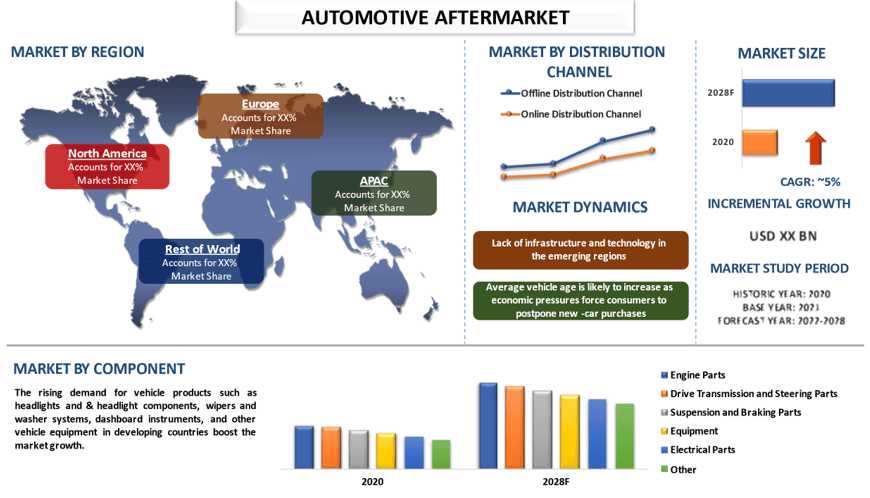
The global Automotive Aftermarket is expected to grow at a significant rate of around 5% during the forecast period 2022-2028
The automotive aftermarket industry is experiencing steady growth, with an anticipated annual increase of around 5%, driven by the surge in vehicle production for both commercial and passenger automobiles. This sector plays a pivotal role in maintaining vehicles by providing a wide array of spare parts, replacement components, and repair services. These services include the installation and maintenance of essential vehicle parts to ensure proper functionality and performance.
Key drivers fueling this growth include rising demand for critical automotive components such as wheels, axles, headlight parts, engine valves, pistons, and piston rings. Moreover, as vehicles require ongoing repairs and maintenance, the automotive aftermarket becomes essential to keeping cars running smoothly. Companies in the sector are focusing on innovations like advanced turbochargers to meet the rising consumer demand for high-performance vehicle parts. For example, in June 2021, MAN Energy Solutions and Rolls-Royce partnered to distribute cutting-edge turbocharger technology, combining Rolls-Royce’s high-efficiency MTU turbochargers with MAN’s global sales network.
Market Segmentation
The automotive aftermarket market is divided into several key categories based on components, distribution channels, and regional demand.
By Component:
Engine Parts: This category includes essential parts like pistons, piston rings, engine valves, and fuel injection systems.
Drive Transmission and Steering Parts: Key components like gearboxes, steering systems, and axles fall into this segment.
Suspension and Braking Parts: Includes brake pads, calipers, and suspension systems, all of which are integral to vehicle safety.
Equipment: This category covers items such as headlights, wipers, washer systems, and dashboard instruments, which have seen increased demand, particularly in developing regions.
Electrical Parts: Important for vehicle electrical systems, this category encompasses starter motors, spark plugs, ignition systems, and batteries.
Others: Includes additional components that may not fit into the above categories.
Access sample report (including graphs, charts, and figures): https://univdatos.com/reports/automotive-aftermarket?popup=report-enquiry
By Distribution Channel:
Offline Distribution: Traditionally, automotive aftermarket parts were sold through physical stores or service stations.
Online Distribution: The online channel has seen exponential growth, providing consumers with convenience, discounted prices, and home delivery for bulky parts. This trend is expected to continue as more customers turn to e-commerce for their automotive needs.
By Region:
North America: The U.S. and Canada represent key markets due to the robust automotive culture and the large volume of vehicles requiring replacement parts and maintenance services.
Europe: Countries like Germany, the U.K., France, and Italy dominate the European market, driven by high vehicle ownership and advanced automotive technologies.
Asia-Pacific: The region is anticipated to experience the fastest growth in the coming years, fueled by a growing middle class, higher disposable incomes, and an increasing preference for electric and high-performance vehicles.
Rest of the World: Other regions, including the Middle East, Africa, and Latin America, are seeing growing automotive markets, contributing to the overall demand for aftermarket products.
Key Trends and Developments
Several factors are influencing the growth and transformation of the automotive aftermarket industry:
Rise of Electric Vehicles (EVs): The growing shift towards electric vehicles has led to an increase in demand for specialized parts like batteries and electrical systems. This trend is particularly pronounced in regions like Asia-Pacific, where EV adoption is accelerating.
Click here to view the Report Description & TOC: https://univdatos.com/reports/automotive-aftermarket
Technological Innovations: Advances in turbocharging, fuel efficiency, and overall vehicle performance are pushing aftermarket companies to launch products that cater to high-performance vehicles. Partnerships between major automotive companies, like the MAN Energy Solutions and Rolls-Royce collaboration, demonstrate the importance of innovation in staying competitive.
E-commerce Expansion: The shift to online sales platforms has revolutionized the way consumers purchase automotive parts. Offering easy access to a wide variety of products, online platforms allow consumers to conveniently order parts with added perks like discounts, home delivery, and easy payment options.
Conclusion
The automotive aftermarket industry is evolving rapidly, driven by technological innovations, growing vehicle production, and shifting consumer preferences toward online shopping. As manufacturers and suppliers continue to diversify their offerings to meet the growing demand for spare parts, the sector’s growth is expected to remain steady. With APAC emerging as the fastest-growing region, the automotive aftermarket market is poised for a promising future, supported by the rise in disposable incomes, increased vehicle production, and a focus on electric and high-performance cars.
Contact Us:
UnivDatos
Email: contact@univdatos.com
Contact no: +1 978 7330253
Website: www.univdatos.com

















